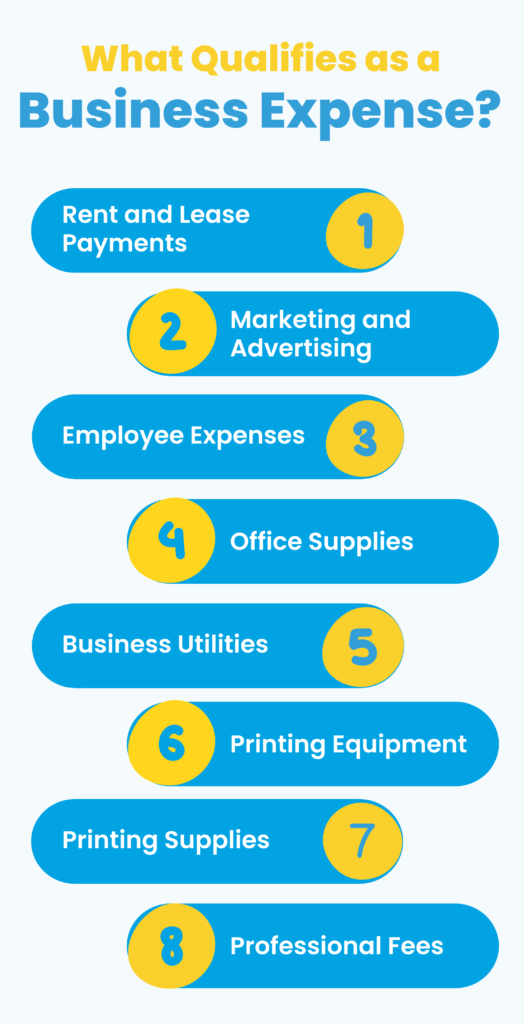
In the printing industry, it's important to keep coming up with new ideas and work efficiently to stay ahead. But during tax season, things can slow down. This blog is here to help printing business people learn how to get the most out of their tax deductions. We'll talk about specific things you spend money on, like supplies, and different ways to save on taxes. The goal is to help you keep more of the money you make. Let's tackle together and make sure your printing business does well all year long.
Running a printing business involves various expenses, and fortunately, many of these qualify as tax deductions, helping reduce your taxable income. Let's check what qualifies as a business expense and how to keep proper records for tax deductions.

Paper, ink, toner cartridges – these are the lifeblood of your business. The good news? They're entirely deductible! According to industry reports, the average printing business spends 20-30% of its revenue on supplies. By strategically sourcing and managing these costs, you can unlock significant savings.
Printers, scanners, and other equipment are significant investments. The IRS allows you to recover this cost through depreciation. This means you can deduct a portion of the equipment's price each year over its useful life (typically 3-5 years for printing businesses, according to a Printing Industries of America study). Understanding depreciation helps with strategic equipment purchases by spreading the tax burden and potentially maximizing tax benefits.
Skilled employees are your most valuable asset. The salaries, bonuses, and benefits you provide are fully deductible business expenses. Competitive compensation packages not only attract top talent but also contribute to a productive and successful business. (Bureau of Labor Statistics reports an average median wage of $43,610 for printing occupations).
Design software, accounting programs, and other essential tools can be deductible business expenses. However, the deductibility depends on factors like:
Reaching new customers is vital for any business. The good news? The costs associated with promoting your printing services – website development, online advertising, brochures – are fully deductible. A Statista report indicates that global printing industry advertising spending is expected to reach $52 billion by 2024. Tracking and claiming these marketing expenses can significantly reduce your tax burden. It's always advisable to consult with a tax advisor to ensure you're following proper tax regulations for marketing deductions.
To claim these deductions, you'll need to maintain proper records of your business expenses. Here's how:
Always consult with a tax professional for the latest regulations on specific deductions.
Running a business goes way beyond printing flyers and reports. There are a variety of expenses you might incur that can be deducted on your tax return, helping you keep more money in your pocket. Let's dive into some key areas:
Imagine a fire damages your printing equipment or a client sues over a printing error. Business insurance can be a lifesaver for unexpected events.
While the SBA statistic about business failure rates is interesting, it might be more impactful to focus on specific risks relevant to printing businesses. Here are some examples:
The premiums you pay for these essential coverages are typically tax-deductible, offering a financial safety net for your printing business.
Your printing equipment is the backbone of your business. The good news is, the IRS allows you to claim tax deductions for these valuable assets. Here's how:
Staying ahead of the curve is crucial for business success. Subscriptions to industry publications, software essential for your operations, or even online courses to sharpen your skills can all be tax-deductible. A 2023 study by the Association for Continuing Education found that businesses that invest in employee training see a 21% higher profit margin. Remember, the subscription or resource needs to be directly related to your business.
Speaking of staying ahead, investing in your own knowledge and skills through training and continuing education can be a smart move. Whether it's attending conferences, taking workshops, or enrolling in online courses relevant to your field, these expenses are often tax-deductible. It's a win-win – you improve your expertise and potentially save on taxes!
Remember: It's always best to consult with a tax professional to ensure you're deducting all eligible business expenses and following the latest tax regulations.
Depreciation allows you to deduct the cost of a business asset (like a printer) over its useful life. Instead of claiming the entire cost upfront, you spread it out over several years, reducing your taxable income in each year.
The IRS provides a guide on depreciation methods and useful life estimations in Publication 946 IRS Publication 946. For printers, the IRS typically classifies them as five- or seven-year property.
Example
You purchase a new printer for $5,000. Assuming a five-year useful life and using the straight-line method, you can deduct 1/5th of the cost ($1,000) each year for five years.
Section 179 offers a tax advantage for qualifying equipment purchases. It allows you to deduct the entire cost of the equipment in the year it is placed in service, rather than depreciating it over time. This can significantly reduce your current year's taxable income.
Here's what you need to know about Section 179
Example
It's crucial to keep track of your depreciation deductions. Here's how:
The best option depends on your specific circumstances. Consider factors like:
Consulting a tax professional can help you determine the most advantageous approach for your printing business.
Understanding tax deductions can significantly benefit your printing business's bookkeeping. By strategically claiming deductions for allowable expenses can reduce your taxable income and keep more of your hard-earned money. Remember, record-keeping is crucial, so maintain organized receipts and consider outsourcing accounting services.
Bookkeeperlive can streamline this process and ensure accuracy. With years of specialized experience, Bookkeeperlive is your go-to partner for managing finances in the printing industry. We excel in categorizing income and outgoings, tracking expenses, and generating insightful reports. Our expertise ensures you claim all eligible deductions and stay compliant with tax regulations.
1. Can I deduct the cost of repairs and maintenance for my printing equipment?
Yes, repairs and maintenance costs for equipment used in your business are generally deductible.
2. I work from home and have a dedicated space for my printing business. Can I deduct any home office expenses?
Yes, you may be able to deduct a portion of your home office expenses based on the percentage of space used for business purposes. However, there are specific IRS guidelines for home office deductions.
3. I pay for software subscriptions specific to printing (e.g., design software). Is this deductible?
Yes, software subscriptions used exclusively for your business are deductible.
4. I buy a lot of paper in bulk to get a discount. Can I deduct the entire cost upfront?
The IRS may require you to inventory your supplies and deduct them as they are used. Consult with a tax professional for specifics.
5. What about employee benefits (health insurance, etc.)? Are those deductible?
Yes, employee benefits you pay for your workers are generally deductible as a business expense.
In the printing industry, it's important to keep coming up with new ideas and work efficiently to stay ahead. But during tax season, things can slow down. This blog is here to help printing business people learn how to get the most out of their tax deductions. We'll talk about specific things you spend money on, like supplies, and different ways to save on taxes. The goal is to help you keep more of the money you make. Let's tackle together and make sure your printing business does well all year long.
Running a printing business involves various expenses, and fortunately, many of these qualify as tax deductions, helping reduce your taxable income. Let's check what qualifies as a business expense and how to keep proper records for tax deductions.

Paper, ink, toner cartridges – these are the lifeblood of your business. The good news? They're entirely deductible! According to industry reports, the average printing business spends 20-30% of its revenue on supplies. By strategically sourcing and managing these costs, you can unlock significant savings.
Printers, scanners, and other equipment are significant investments. The IRS allows you to recover this cost through depreciation. This means you can deduct a portion of the equipment's price each year over its useful life (typically 3-5 years for printing businesses, according to a Printing Industries of America study). Understanding depreciation helps with strategic equipment purchases by spreading the tax burden and potentially maximizing tax benefits.
Skilled employees are your most valuable asset. The salaries, bonuses, and benefits you provide are fully deductible business expenses. Competitive compensation packages not only attract top talent but also contribute to a productive and successful business. (Bureau of Labor Statistics reports an average median wage of $43,610 for printing occupations).
Design software, accounting programs, and other essential tools can be deductible business expenses. However, the deductibility depends on factors like:
Reaching new customers is vital for any business. The good news? The costs associated with promoting your printing services – website development, online advertising, brochures – are fully deductible. A Statista report indicates that global printing industry advertising spending is expected to reach $52 billion by 2024. Tracking and claiming these marketing expenses can significantly reduce your tax burden. It's always advisable to consult with a tax advisor to ensure you're following proper tax regulations for marketing deductions.
To claim these deductions, you'll need to maintain proper records of your business expenses. Here's how:
Always consult with a tax professional for the latest regulations on specific deductions.
Running a business goes way beyond printing flyers and reports. There are a variety of expenses you might incur that can be deducted on your tax return, helping you keep more money in your pocket. Let's dive into some key areas:
Imagine a fire damages your printing equipment or a client sues over a printing error. Business insurance can be a lifesaver for unexpected events.
While the SBA statistic about business failure rates is interesting, it might be more impactful to focus on specific risks relevant to printing businesses. Here are some examples:
The premiums you pay for these essential coverages are typically tax-deductible, offering a financial safety net for your printing business.
Your printing equipment is the backbone of your business. The good news is, the IRS allows you to claim tax deductions for these valuable assets. Here's how:
Staying ahead of the curve is crucial for business success. Subscriptions to industry publications, software essential for your operations, or even online courses to sharpen your skills can all be tax-deductible. A 2023 study by the Association for Continuing Education found that businesses that invest in employee training see a 21% higher profit margin. Remember, the subscription or resource needs to be directly related to your business.
Speaking of staying ahead, investing in your own knowledge and skills through training and continuing education can be a smart move. Whether it's attending conferences, taking workshops, or enrolling in online courses relevant to your field, these expenses are often tax-deductible. It's a win-win – you improve your expertise and potentially save on taxes!
Remember: It's always best to consult with a tax professional to ensure you're deducting all eligible business expenses and following the latest tax regulations.
Depreciation allows you to deduct the cost of a business asset (like a printer) over its useful life. Instead of claiming the entire cost upfront, you spread it out over several years, reducing your taxable income in each year.
The IRS provides a guide on depreciation methods and useful life estimations in Publication 946 IRS Publication 946. For printers, the IRS typically classifies them as five- or seven-year property.
Example
You purchase a new printer for $5,000. Assuming a five-year useful life and using the straight-line method, you can deduct 1/5th of the cost ($1,000) each year for five years.
Section 179 offers a tax advantage for qualifying equipment purchases. It allows you to deduct the entire cost of the equipment in the year it is placed in service, rather than depreciating it over time. This can significantly reduce your current year's taxable income.
Here's what you need to know about Section 179
Example
It's crucial to keep track of your depreciation deductions. Here's how:
The best option depends on your specific circumstances. Consider factors like:
Consulting a tax professional can help you determine the most advantageous approach for your printing business.
Understanding tax deductions can significantly benefit your printing business's bookkeeping. By strategically claiming deductions for allowable expenses can reduce your taxable income and keep more of your hard-earned money. Remember, record-keeping is crucial, so maintain organized receipts and consider outsourcing accounting services.
Bookkeeperlive can streamline this process and ensure accuracy. With years of specialized experience, Bookkeeperlive is your go-to partner for managing finances in the printing industry. We excel in categorizing income and outgoings, tracking expenses, and generating insightful reports. Our expertise ensures you claim all eligible deductions and stay compliant with tax regulations.
1. Can I deduct the cost of repairs and maintenance for my printing equipment?
Yes, repairs and maintenance costs for equipment used in your business are generally deductible.
2. I work from home and have a dedicated space for my printing business. Can I deduct any home office expenses?
Yes, you may be able to deduct a portion of your home office expenses based on the percentage of space used for business purposes. However, there are specific IRS guidelines for home office deductions.
3. I pay for software subscriptions specific to printing (e.g., design software). Is this deductible?
Yes, software subscriptions used exclusively for your business are deductible.
4. I buy a lot of paper in bulk to get a discount. Can I deduct the entire cost upfront?
The IRS may require you to inventory your supplies and deduct them as they are used. Consult with a tax professional for specifics.
5. What about employee benefits (health insurance, etc.)? Are those deductible?
Yes, employee benefits you pay for your workers are generally deductible as a business expense.
BookkeeperLive provides affordable bookkeeping and accounting services tailored to your business goals.





No calls, No meetings, No spam. Get started with a free trial by filling out the form.
*NDA included for your data protection.
Copyright © 2025 BookkeeperLive. All rights reserved. Privacy Policy Terms of Use
Enter the code, fill out the form, and unlock financial clarity with a free trial.